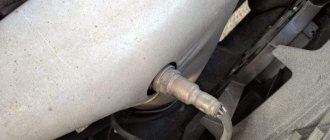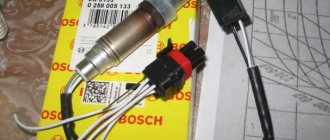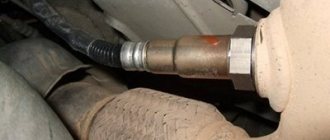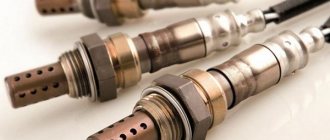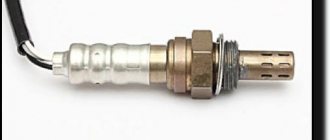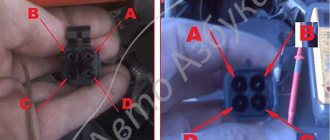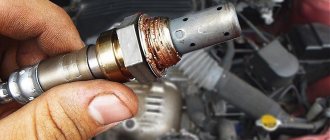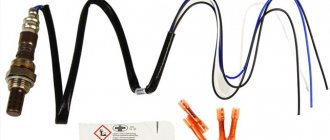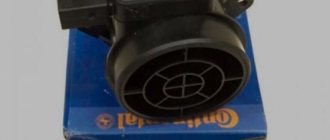The lambda probe is an oxygen controller. It is used to control and balance the proportions of air and fuel during the formation of a combustible mixture. Correct functioning of the element will prevent destabilization of the motor's operating process. To determine the cause of the breakdown, you need to know the signs of a malfunctioning lambda probe.
External signs and causes
If the lambda probe heating system or the device itself in the car does not work, the symptoms of the malfunctioning condition will be as follows:
- The power unit began to operate less stably. The revolutions can spontaneously increase and fall. The engine often stalls, especially at traffic lights.
- The quality of the combustible mixture, which is pumped with air into the cylinder system, has decreased. If the sensor is not functioning properly, this will cause excessive fuel consumption.
- The fuel supply has become ineffective, fuel enters the combustion chambers uncontrollably. This can lead to malfunctions in the operation of the unit, as well as the electronic system of the car.
- Over time, the engine may experience intermittency when operating at idle speed. At maximum, the efficiency of the internal combustion engine will also be less low.
- There were problems with the functioning of electronic systems. Due to the need to repair the sensor, individual compartments of the power unit will operate unstably. This is due to the fact that pulsed fault signals are sent with a delay.
- While driving, the vehicle began to jerk. Especially when the car is going uphill.
- When the engine operates at any speed, popping noises may appear.
- The engine began to respond slowly to pressing the gas pedal. Acceleration occurs, but not immediately.
One of the important symptoms is the lightning of the Check Engine indicator or the oxygen controller failure light on the car’s dashboard.
The reasons why the performance of the oxygen sensor will be impaired may not arise immediately, so failure of the part occurs in several stages:
- At first, the oxygen sensor begins to function unstably. Periodically, the signal from the device disappears, information is provided over a wide range. This leads to deterioration in the quality of the combustible mixture, as well as unstable speed operation. At the initial stage, the car jerks when moving, popping noises uncharacteristic of the operation of the internal combustion engine appear, and a malfunction indicator may light up on the dashboard.
- At the next stage, the lambda probe stops functioning on a cold engine until the unit warms up. The symptoms of the problem will be similar, only they will appear with greater force. The engine power of the car may decrease, and a response will appear when you press the gas pedal. As a result, this can lead to overheating of the internal combustion engine.
- At the third stage, the oxygen sensor usually fails completely. The power of the power unit drops even more, this is clearly evident when driving at high speed. An unpleasant and pungent odor appears from the muffler.
Reasons that may cause a breakdown of the oxygen sensor:
- The device casing has depressurized. Because of this, exhaust gases and air began to get inside.
- Controller overheating. The reason may be due to malfunctions in the ignition system or incorrectly performed tuning of the power unit.
- Long-term exposure to external factors. This reason can be attributed to natural wear and tear, since any oxygen sensor fails over time.
- The working surface of the oxygen sensor is covered with combustion products, which block its operation. This is usually due to the regular use of low-quality fuel.
- There is a power failure or the wiring leading to the central control unit is damaged.
- Mechanical damage to the device. A strong blow to the case may destroy the internal components of the controller. This often occurs during regular off-road driving.
The “Online auto parts store” channel talked about the causes of malfunctions in the operation of oxygen controllers.
Is it possible to drive with P0135?
Older injection systems initially retain a “wait” for warming up, that is, in the worst case, fuel consumption will slightly increase (due to the fact that reaching the “closed loop” during warming up will begin to lag). Many cars easily drive several thousand until the owner gets tired of the Check Engine light being on.
In the future, this emergency algorithm was preserved, the only “but” in the larger “choke” under strict economic standards. That is, a modern car will not experience serious problems with faulty heating if the sensor itself is working properly.
However, if the error occurs randomly (that is, after a reset, not immediately after turning on the ignition, when the self-test is running, but with a random delay or even while driving), then this indicates more serious problems. Thus, there are known cases when, to eliminate error P0135, dealers replaced defective wiring harnesses on Kia Ceed. If the error occurs due to a bad contact on the ECU connector, then it is unlikely that the problem is only in one contact out of several dozen (or even more than a hundred), there may be further “surprises”.
How to check with a multimeter
Before diagnosing the oxygen sensor itself, its heating device is checked.
The tester can check the operation of the heating component of the oxygen sensor:
- The diagnostic device switches to the resistance parameter measurement mode.
- The probes of the device are connected to the heater contacts. These elements are usually made of cable with a large cross-section.
- The contacts of the heating device are ringing.
- If the heating element is working, then the resulting resistance value will be less than 10 ohms. If this parameter is higher, then the electric heating device has failed and needs to be replaced.
The tester checks like this:
- Locate the controller mounting location under the hood of your vehicle.
- Connect the multimeter probes to the signal outputs of the sensor or electrical circuits. The tester itself sets the measurement limit to 2 volts.
- At the next stage, it is necessary to artificially create a situation of an over-enriched combustible mixture. To do this, you can use the throttle change method by periodically pressing the gas pedal. Or you can remove the pressure sensor connector.
- Then the readings given by the tester are read. Ideally, they should be from 0.8 volts, this indicates that the oxygen sensor is working properly.
- It is necessary to artificially create a lean mixture situation. To do this, you can create an air leak by slightly loosening the air duct clamp. With a lean mixture, the tester reading should be no more than 0.2 volts.
V_i_t_a_l_y talked about diagnosing the oxygen controller using a multimeter.
Device diagram
Let's look at the probe diagram, which gives an idea of the placement of nodes. Knowledge of the design allows you to understand the locations of parts that are prone to failure.
Probe design example
The design includes:
- 1 - metal fitting intended for installing a probe, there are turnkey edges on the outer surface, a thread is located below;
- 2 - ceramic insulator;
- 3 — sealing element for inserting the wiring harness;
- 4 - signal wires;
- 5 - metal protective cap, equipped with ventilation vents, designed to protect the measuring element from damage;
- 6 — spring contact part;
- 7 - sensitive element made of ceramic;
- 8 - heating rod;
- 9 - ventilation duct;
- 10 - outer metal casing.
We recommend: What kind of TSI engine?
Other diagnostic methods
If signs of a lambda probe malfunction appear, you can use computer diagnostics to check its functionality. It allows you to monitor the operating parameters of the oxygen sensor online.
You can use an oscilloscope for diagnostics. If the test shows that the lower limit of the device drops to zero volts, then the controller is working, but it will need to be changed soon. If the time dependence of the voltage at the signal contact is characterized by greater smoothness, then it is time to replace the sensor.
It is correct to start diagnosing four-pin oxygen sensors with a visual inspection; this procedure is recommended to be performed every 10 thousand kilometers. For testing, the controller is removed from the manifold; WD-40 or brake fluid cannot be used, since their contact with the working surface will cause it to break. If special means are used when unscrewing coked threads, their residues are removed before removing the device.
Assess the color and condition of the operating area of the oxygen controller. If traces of soot are visible on it, this indicates an over-enriched combustible mixture in the engine. Its presence leads to contamination of the device, so to ensure better performance, soot must be removed. A gray or white coating indicates the use of additives in motor fluid or fuel. The presence of a shiny coating indicates that the concentration of lead in the fuel used is exceeded. If the coating is intense, then the sensor cannot be repaired; it must be replaced.
Operating principle of the oxygen sensor
The principle of operation of the oxygen sensor is quite simple. The lambda probe must compare the readings with some ideal results in order to understand how the percentage of oxygen in the mixture changes, so measurements are taken in two places - atmospheric air and combustion products .
This approach allows the sensor to feel the difference if the fuel mixture ratio changes.
The ECU must receive an electrical impulse from the lambda probe. To do this, the sensor must be able to convert measurements into electrical signals. For measurements, special electrodes are used that can react with oxygen.
Lambda uses the principle of galvanic cells - changing the conditions of chemical reactions leads to a change in the voltage between the two electrodes. When the mixture is rich and the oxygen content is below the lower threshold, then the voltage rises. If the mixture is lean, the voltage will drop.
Next, the impulse that occurs at the stage of chemical reactions is sent to the ECU, where the parameters are compared with the fuel maps stored in the memory. As a result, the operation of the power system is adjusted.
Related article: How to make a foam generator for a car wash with your own hands
The oxygen sensor operates on chemical reactions, but its design is relatively simple. The main element is a special tip made of ceramic materials. Zirconium dioxide and, less commonly, titanium dioxide are used as raw materials.
The tip is coated with platinum - it is this layer that reacts with oxygen. One side of this tip is in contact with the exhaust gases, the other side with the air in the atmosphere.
The lambda probe electrodes have one feature. So that the reaction is more efficient and the indicators are accurate, measurements of the oxygen content in the exhaust are carried out under certain temperatures.
In order for the tip to reach the performance characteristics and the required electrical conductivity, the temperature of the environment should be 300-400 degrees.
To ensure the required temperature regime, the lambda probe was initially installed in close proximity to the exhaust manifold. This ensured the desired temperature after warming up the internal combustion engine. The sensor did not start working immediately. Before the lambda warmed up enough and began to produce accurate parameters, the ECU used signals from other sensors. The optimal mixture was not prepared during the heating process.
Some oxygen sensor models are equipped with electric heaters. Thanks to them, the lambda can quickly reach operating temperature conditions. Heating uses energy from the vehicle's on-board network.
Instructions for repairing and replacing the sensor
You can replace or restore the controller yourself.
How to remove the sensor
Removing the device, regardless of the machine model, is done as follows:
- Warm up the surface of the part to approximately 60 degrees. To do this, you can use a regular lighter or torch. Warming up will make it easier to remove the device from the seat.
- Disconnect the wires connected to the part.
- Carefully unscrew the oxygen sensor. It is not recommended to use special tools for dismantling.
- Remove the protective cap.
Diman Stepanenko spoke about dismantling the lambda probe on his own.
Cleaning and Soaking
There are two options for restoring the oxygen sensor:
- the first - using orthophosphoric acid;
- the second - with phosphoric acid and a burner.
It must be taken into account that phosphoric acid or another similar product belongs to the category of hazardous substances. When working with a substance, it is important to remember safety rules. Acid should not be allowed to enter the mucous membranes or inside the body.
First way
This method cannot be called accelerated, since the consumer needs to gain full or at least partial access to the ceramic surface of the device. This component is hidden behind a protective cap made of metal; it is not easy to dismantle. Do not use a hacksaw for removal as it will damage the work surface. Dismantling is carried out using a lathe - at the base of the oxygen sensor, you need to cut off the protective cap using a cutter. The cutting is done close to the thread.
If it is not possible to use the machine, you can use a file. It is not possible to completely remove the cap with this tool, but you can make small windows about 5 mm in size on it. Approximately 100 ml of orthophosphoric acid is used for cleaning. If it is not available, you can use a rust converter.
Device recovery:
- Pour the liquid into a glass container. You can use jars, glasses, etc.
- Place the oxygen sensor core into the container. The controller cannot be completely immersed in liquid. Wait about twenty minutes.
- Remove the sensor from the container and rinse its base with tap water. Wait until the device is completely dry.
- If you are unable to remove the dark deposits on the core the first time, repeat the procedure. It is necessary to ensure that the element again becomes a metallic color.
- If, after several attempts, high-quality cleaning fails, you can use a brush to enhance the effect of the product. The base of the device is wetted and treated with it. As a result, the plaque should be removed. If the protective cap has been removed, then the brush will not be needed. It is better to use a toothbrush instead.
- After cleaning has been completely completed, the sensor is washed. If the cap has been removed, then after restoration it must be put back in place. For this, argon welding is used.
When using this method, please note:
- If the device is heavily soiled, then twenty minutes will not be enough to restore it. For critical blockages, the soaking procedure can be extended to three hours. In some situations, cleaning may take a full night, at least eight hours.
- After cleaning, you need to check how effectively the procedure was performed. Diagnostics will require some time for the car owner to understand how the car behaves and how much fuel it “eats.” If the malfunction indicator on the device remains lit, then the controller could not be repaired.
- If the machine is equipped with a sensor whose protective cap is equipped with a double shell, then it will not be possible to make a hole in it with a file. To solve the problem, you need to soak the device in acid or another product with the cap itself.
The process of cleaning the oxygen controller is shown by Alexander Sabegatulin.
Second way
To restore the controller you will need the same acid, as well as a gas burner or stove. When using a household stove, give preference to a small burner.
Cleaning procedure:
- The lid is removed from the burner. Then it is turned over and installed back, with a slight offset to the side. It is necessary to install the lid so that it covers the pipe itself from liquid getting inside.
- The fire on the burner is lit.
- The lambda probe core must be dipped in a container of acid, then taken with pliers and heated over a fire. This will cause the acid to boil and the substance will begin to splash. A greenish tint of salt will appear on the working surface of the device.
- Wait until the substance has completely boiled away. Rinse the controller with clean water and then repeat the cleaning procedure. These steps must be continued until the controller is completely shiny. This may take ten minutes or more. Before further installation, the thread of the lambda probe must be treated with graphite lubricant, which will prevent the oxygen sensor from sticking to the threaded hole.
Installing a lambda probe
Installation of the device is carried out in the reverse order:
- A protective cap is installed on the sensor.
- Wires are connected to the device.
- The controller is installed in the seat and screwed in.
Symptoms of lambda sensor failures
The device has a limited service life, intended for a maximum mileage of 150,000 km. However, in practice, already at 80 thousand mileage problems begin in this device. If you do not replace a faulty device in time, this will lead to breakdown of the catalyst. Buying and replacing a catalyst will cost you a pretty penny.
The driver himself can understand when something is wrong with the sensor.
- When in idle mode, “triple” is felt, but the ignition is working properly;
- A noticeable increase in fuel consumption;
- Dips in acceleration, variable dynamics, loss of power;
- And, of course, the “CHECK ENGINE” button lit up.
A faulty sensor causes the formation of heavy carbon deposits throughout the entire fuel system and the formation of smoke in many important parts, which results in their incorrect operation or failure.
How to make a corrector (fake) lambda probe?
There are several types of correctors for oxygen controllers. The mechanical device is the simplest and most affordable in terms of corrector design. It is necessary to machine a special adapter into which the lambda probe is installed, as well as a mini-catalyst. After this, the assembled device is mounted in the standard place of the car muffler.
If the catalyst device or the oxygen sensor installed after it breaks down, a signal will be sent to the control unit. The module will be warned that the exhaust gases contain harmful substances, the volume of which exceeds the permissible value. The control unit will perceive this event as an emergency and increase the fuel supply to enrich the air-fuel mixture.
When installing such a corrector, exhaust gases will flow through a small hole in the adapter into the catalyst device. The latter is filled with ceramic dust with a catalytic layer. The concentration of harmful substances in the exhaust gases will be lower. The control module will perceive this as the correct operation of the controller and standard catalyst device. The manufacture of blende is carried out using a lathe and a diagram; steel or bronze can be used as a material.
Scheme of a mechanical corrector for a lambda probe
Universal drawings that can be found on the Internet may not be suitable for making a lambda probe blende for a specific car model; you need to look for a proven option.
Making an electronic controller fake:
- Using the SprintLayout program and a printer, a layout drawing and arrangement of circuit elements are printed. Printing is done on glossy paper.
- When sending a file for printing, you must select 100% black for layer K1. In the program, check the box next to Mirror and Scheme Outline. All other layers are deleted.
- Then the next layer is sent for printing. For the M2 layer, the color is black. The checkbox opposite the Mirror item is removed, but it remains opposite the second element. Other layers are removed.
- When performing the task, it is recommended to use foil textolite. It must be one-sided, and its thickness will be no less than 1 and no more than 2 mm.
- When the printout is in hand, it must be transferred to the LM324 board using an iron. The board itself is cut out taking into account the dimensions, and printouts must be made along its contour. After cutting, attach the diagram to the drawing; the dimensions must match exactly.
- Using fine-grained sandpaper, the copper layer is cleaned. The board is cleaned using fuel or solvent.
- Then you need to transfer the printout with the tracks to the working surface of the board. A printed layer of elements is installed on the reverse (copper surface). To do this, foil paper is applied to the board and heated with an iron; the procedure takes no more than 10 minutes. When warming up, the surface of the iron should be pressed as close as possible to the board. As a result, the toner should be reprinted from the foil surface onto the circuit. If the paper density is low, the tracks will be visible. The problem can be corrected using a permanent black marker.
- The next step will be etching, this will require ferric chloride or sodium perchlorate.
- Then holes are drilled on the board and the elements are soldered.
- At the final stage, the operating parameters of the corrector are adjusted. To do this, +950 mV is supplied to the input, and the voltage value is adjusted in the range from 950 to 1000 mV. For the LM324 board, the procedure is done by setting up elements VR3 and VR4.
Circuit for making electronic decoy
Printout of the circuit for installation on the board
Connecting all components on the decoy board
Restoring correct operation of the λ-probe
Error codes will need to be reset from the ECU after troubleshooting. Moreover, if the cause is low-quality gasoline, you will have to drain it and fill it with high-quality fuel. And only after that reset the codes.
If breaks are detected, you need to solder the connected parts.
Clean dirt and carbon deposits with active reagents.
The lambda probe is a consumable item. If you have diagnosed its final breakdown, then it needs to be replaced. It cannot be repaired, since damaged precious metal threads cannot be replaced, even at dealer service centers.
You can replace the old probe with an original or universal device from Bosch. Mounting with an adapter makes it suitable for any make of car. When installing a new sensor, do not forget to lubricate its threaded part with sealant.
Timely replacement of the lambda probe, even if it has simply exhausted its service life, will increase engine power and ensure its uninterrupted operation.
What is the price?
The cost of the device will vary depending on the manufacturer and brand of the machine.
| Name | Price, rub |
| Lambda probe for Volkswagen Golf | From 2900 to 8000 rubles depending on the brand |
| Oxygen sensor for VAZ cars | From 1900 to 4200 rubles depending on the car brand |
| Lambda probe for Daewoo cars | From 800 to 6 thousand rubles on average |
| Oxygen controller for Renault cars | From 1800 to 8 thousand rubles depending on the brand |
| Prices are relevant for three regions: Moscow, Chelyabinsk, Krasnodar. | |
